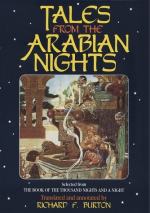[FN#236] These childish indecencies are often attributed to Bhang-eaters. See “Bakun’s Tale of the Hashish-eater,” vol. ii. 91. Modest Scott (vi. 129) turns the joke into “tweaking the nose.” Respectable Moslems dislike the subject, but the vulgar relish it as much as the sober Italian enjoys the description of a drinking bout—in novels.
[FN#237] In the text “Finjal,” a vulgarism for “Finjan”: so the converse “Isma’in” for “Ism’ail” = Ishmael. Mr. J. W. Redhouse (The Academy No. 764) proposes a new date for coffee in Al-Yaman. Colonel Playfair (History of Yemen, Bombay 1859) had carelessly noted that its “first use at Aden was by a judge of the place who had seen it drunk at Zayla’, on the African coast opposite Aden,” and he made the judge die in A.H. 875 = A.D. 1470. This is about the date of the Shaykh al-Shazali’s tomb at Mocha, and he was the first who brought the plant form about African Harar to the Arabian seaboard. But Mr. Redhouse finds in a Turkish work written only two centuries ago, and printed at Constantinople, in A.D. 1732, that the “ripe fruit was discovered growing wild in the mountains of Yemen (?) by a company of dervishes banished thither.” Finding the berry relieve their hunger and support their vigils the prior, “Shaykh ’Umar advised their stewing it (?) and the use became established. They dried a store of the fruit; and its use spread to other dervish communities, who perhaps (?) sowed the seed wherever it would thrive throughout Africa (N.B. where it is indigenous) and India (N.B. where both use and growth are quite modern). From Africa, two centuries later, its use was reimported to Arabia at Aden (?) by the judge above mentioned, who in a season of scarcity of the dried fruit (?) tried the seed” (N.B. which is the fruit). This is passing strange and utterly unknown to the learned De Sacy (Chrest. Arab. i. 412-481).
[FN#238] Koran iii. 128. D’Herbelot and Sale (Koran, chap. iii. note) relate on this text a noble story of Hasan Ali-son and his erring slave which The Forty Vezirs (Lady’s eighth story, p. 113) ignorantly attributes to Harun al-Rashid:—Forthwith the Caliph rose in wrath and was about to hew the girl to pieces, when she said, “O Caliph, Almighty Allah saith in His glorious Word (the Koran), ‘And the stiflers of Wrath’” (iii. 128). Straightway the Caliph’s wrath was calmed. Again said the girl, “’And the pardoners of men.’” (ibid.) Quoth the Caliph, “I have forgiven the crimes of all the criminals who may be in prison.” Again said the slave-girl, “‘And Allah loveth the beneficent.’” (ibid.) Quoth the Caliph, “God be witness that I have with my own wealth freed thee and us many male and female slaves as I have, and that this day I have for the love of Allah given the half of all my good in alms to the poor.” This is no improvement upon the simple and unexaggerated story in Sale. “It is related of Hasan, the son of Ali, that a slave having once thrown a dish on him boiling hot,




